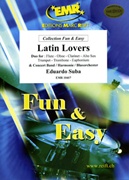Results
-
 £71.50
£71.50All Those Endearing Young Charms - Mantia
This solo has long been standard repertoire for serious euphonium soloists. Composer Mantia was the featured soloist of the Sousa and Pryor bands, and this classic "theme and variations" solo is a fantastic showpiece for euphonium. The solo part, while difficult, allows the soloist to showcase tone, technique and style, and the band accompaniment requires a minimum of preparation. Now available for the first time in a modern concert band arrangement, this is THE SOLO that all euphonium players should learn and know. Outstanding!*Also available with piano accompaniment! 080-4351-38 (bass clef solo) or 080-4351-37 (treble clef solo)
Estimated dispatch 7-14 working days
-
 £64.35
£64.35All Those Endearing Young Charms
This solo has long been standard repertoire for serious euphonium soloists. Composer Mantia was the featured soloist of the Sousa and Pryor bands, and this classic "theme and variations" solo is a fantastic showpiece for euphonium. The solo part, while difficult, allows the soloist to showcase tone, technique and style, and the band accompaniment requires a minimum of preparation. Now available for the first time in a modern concert band arrangement, this is THE SOLO that all euphonium players should learn and know. Outstanding!
Estimated dispatch 7-14 working days
-
 £78.99
£78.99The Old Grumbly Bear
For solo bassoon, bass clarinet, baritone saxophone, euphonium, or tuba with band accompaniment.From the Barnhouse "Spotlight" series. This delightful novelty solo includes parts for solo bassoon, bass clarinet, baritone saxophone, euphonium BC and TC, and Tuba. An ideal solo to showcase your star performer's musical abilities in a humorous and fun way. The accompaniment is not difficult, and requires a minimum of rehearsal. An excellent choice for adding variety to your concert in featuring a soloist on a non-typical solo instrument. Great fun!!
Estimated dispatch 7-14 working days
-
 £64.35
£64.35The Old Grumbly Bear - Fucik, Julius
For solo bassoon, bass clarinet, baritone saxophone, euphonium, or tuba with band accompaniment.From the Barnhouse "Spotlight" series. This delightful novelty solo includes parts for solo bassoon, bass clarinet, baritone saxophone, euphonium BC and TC, and Tuba. An ideal solo to showcase your star performer's musical abilities in a humorous and fun way. The accompaniment is not difficult, and requires a minimum of rehearsal. An excellent choice for adding variety to your concert in featuring a soloist on a non-typical solo instrument. Great fun!!
Estimated dispatch 7-14 working days
-
 £74.99
£74.99Allegro Francaise - Joseph Edouard Barat
Barat's "Andante and Allegro" has been a staple of trombone solo repertoire for decades, and now the Allegro has been excerpted and arranged for the Barnhouse "Spotlight" series by Andrew Glover. An excellent solo to showcase your trombone, euphonium B.C., euphonium T.C., or horn soloist. Band accompaniment is a grade 3, and comes together with a minimum amount of rehearsal time. Solo part is grade 4. A great solo showpiece!
Estimated dispatch 7-14 working days
-
 £57.95
£57.95LATIN LOVERS (Flexible Duet/Easy Concert Band) - Suba, Eduardo
Duo for 2 Solo Instruments. Solo I: Flute - Clarinet - Alto Sax - Trumpet - Trombone - Euphonium. Solo II - Flute - Oboe - Clarinet - Alto Sax - Trumpet - Trombone - Euphonium. American Grade 2+. Duration: 4:12
Estimated dispatch 7-14 working days
-
 £76.99
£76.99O My Beloved Father - Giacomo Puccini
This splendid solo, the aria "O, Mio Babbino Caro" from Puccini's opera "Gianni Schicchi", was arranged by Georges Moreau for Ben Haemhouts, who for many years has been the principal euphonium with the Belgian band "Brassband Midden Brabant". This solo is quite simple and is a real enrichment of the euphonium repertoire. Also for saxophone solos or horn solos.
Estimated dispatch 7-14 working days
-
 £71.50
£71.50Love's Old Sweet Song - Molloy
This beautiful song from the turn-of-the-century is Andrew Glover's latest addition to the Barnhouse "Spotlight" series for solo instrument or voice with band accompaniment. Most effective as a solo for euphonium, trombone, or cornet/trumpet, it includes solo parts and is also playable by solo flute, violin, oboe, clarinet, alto saxophone, or horn. It may also be performed as a vocal solo (medium range from low D up to top-line F.) A masterful arrangement of a wonderful classic song!
Estimated dispatch 7-14 working days
-
 £64.35
£64.35Love's Old Sweet Song
This beautiful song from the turn-of-the-century is Andrew Glover's latest addition to the Barnhouse "Spotlight" series for solo instrument or voice with band accompaniment. Most effective as a solo for euphonium, trombone, or cornet/trumpet, it includes solo parts and is also playable by solo flute, violin, oboe, clarinet, alto saxophone, or horn. It may also be performed as a vocal solo (medium range from low D up to top-line F.) A masterful arrangement of a wonderful classic song!
Estimated dispatch 7-14 working days
-
 £74.99
£74.99Czardas - Vittorio Monti
This lively Hungarian folk dance, originally set for solo violin and piano by Italian composer Vittorio Monti, has been arranged for solo instrument and concert band for the Barnhouse "Spotlight" series by Andrew Glover. This rhapsodical work allows the soloist to display great lyrical skills as well as technical virtuosity! Includes solo parts for violin or flute, b-flat clarinet (or any b-flat instrument in similar range), e-flat alto saxophone, or euphonium (bass clef). Band accompaniment parts grade 3; solo part grade 4+. A great way to feature your outstanding soloist or guest artist, and guaranteed to astonish your audience!
Estimated dispatch 7-14 working days
